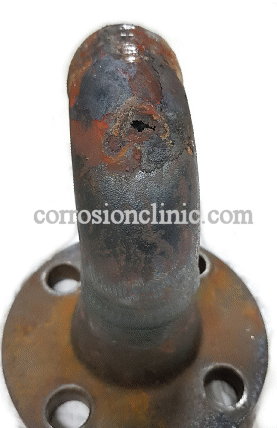|
|
|
|
• EC • Season Cracking • Caustic Embrittlement • Intergranular • SSC • LME • MIC • SCC • HB-HE-HIC • Fatigue • Erosion • FAC • Index |
|
Different Types of
Corrosion
|
|
Flow-Accelerated Corrosion (FAC) |
|
|
Recognition of Flow-Accelerated Corrosion |
|
|
Flow-Accelerated Corrosion (FAC) refers to the combined actions involving the removal of magnetite (Fe3O4) layer by fluid flow and the subsequent increased corrosion of the exposed metal, leading to wall thinning (metal loss) to the extent of perforation. Susceptible components include carbon steel and low alloy steel piping, tubing and vessels exposed to flowing water (single-phase) or wet steam (two-phase), particularly at bends/elbows, Tees, orifices, donwstream of distributors and valves, and any location where turbulent flow exists. Figure 1a FAC at pipe elbow |
|
|
Mechanisms of
Flow-Accelerated Corrosion |
|
|
What causes Flow-Accelerated Corrosion?
The mechanical effect of fluid flow or velocity of a fluid combined with the corrosive action of the fluid causes accelerated loss of metal. The initial stage involves the mechanical removal of a metal's protective film (magnetite Fe3O4) and then corrosion of bare metal by a flowing corrosive occurs. The process is cyclic until perforation of the component occurs.
Figure 1b Mechanisms of Flow-Accelerated Corrosion
Flow-accelerated corrosion is usually found at high flow rates around pipe/tube blockages, tube inlet ends, or in pump impellers. The photo above shows flow-accelerated corrosion of pipe elbow in a wet steam line due to excessively high flow rate of the wet steam.
What are the Factors Influencing FAC? (a) Metallurgy: Cr%, Mo%, Cu%, C% content in carbon steels and alloy steels The metallurgy determines the component's resistance to FAC. Some steel metallurgies are inherently not resistant to FAC while other steel metallurgies are highly resistant to FAC. FAC-Compass (Figure 3 below) computes the FAC resistance index, R, based on the specified steel metallurgy. (b) Fluid Chemistry: Temperature, pH, Oxygen, Steam Quality (c) Flow Pattern (Geometry): Bends/Elbows, Tees, Orifices, Distributors, Turbulence FAC-Compass, the FAC modeling and prediction software, takes account of the above influencing factors in FAC modeling and prediction. The outputs from FAC-Compass include the metallurgy's FAC resistance index, the FAC rate in mm/y, the remaining life of the component, and plots of the FAC rate as a function of temperature, pH, oxygen, (Cr+Mo)%, and velocity (Figure 3).
What is the difference between Erosion Corrosion and Flow-Accelerated Corrosion? In the corrosion literature, erosion corrosion and flow-accelerated corrosion have been frequently used interchangeably. There does not exit a well-defined boundary between the two. Some argue that there is a subtle difference between Erosion Corrosion and Flow-Accelerated Corrosion. In FAC, fluid flow removes magnetite (Fe3O4) layer, exposing steel to corrosion, leading to wall thinning. There is no or thinner magnetite on surface at FAC location due to the flow effect than at locations not subjected to FAC. Figure 2a below shows that the magnetite layer on the tube ID surface was completely removed by high velocity wet steam while Figure 2b shows classic erorion corrosion pattern on the magnetite covered tube ID.
Figure 2a Flow-Accelerated Corrosion showing complete removal of magnetite layer on tube ID surface by high velocity wet steam
Figure 2b Erosion Corrosion showing classic pattern of erorion corrosion on the magnetite-covered tube ID surface
|
|
|
FAC Modeling, Prediction and
Prevention |
|
|
How to prevent Flow-Accelerated Corrosion? Flow-accelerated corrosion can be prevented through: Flow-accelerated corrosion and the remaining life of components can be predicted with software such as FAC-Compass. FAC-Compass is a powerful software tool for Erosion Corrosion/Flow-Accelerated Corrosion Modeling, Life Prediction and Materials Selection in Water-Steam Systems. Click this link for details on the features and functions of the latest version of FAC-Compass for predictive modeling and remaining life prediction.
Figure 3 Overview of FAC-Compass for FAC Modeling and Prediction |
|
|
For more details on
Flow-Accelerated Corrosion (FAC) |
|
|
More details on Erosion Corrosion and FAC are included in the following corrosion courses which you can take as in-house training courses, course-on-demand, online courses or distance learning courses:
If you require corrosion expert witness or corrosion consulting service on flow-accelerated corrosion, our NACE certified Corrosion Specialist is able to help. Contact us for a quote. |
|
| Home | Subject Index | Contact Us | PDF |
Copyright © 1995-2025.. All rights reserved. |
